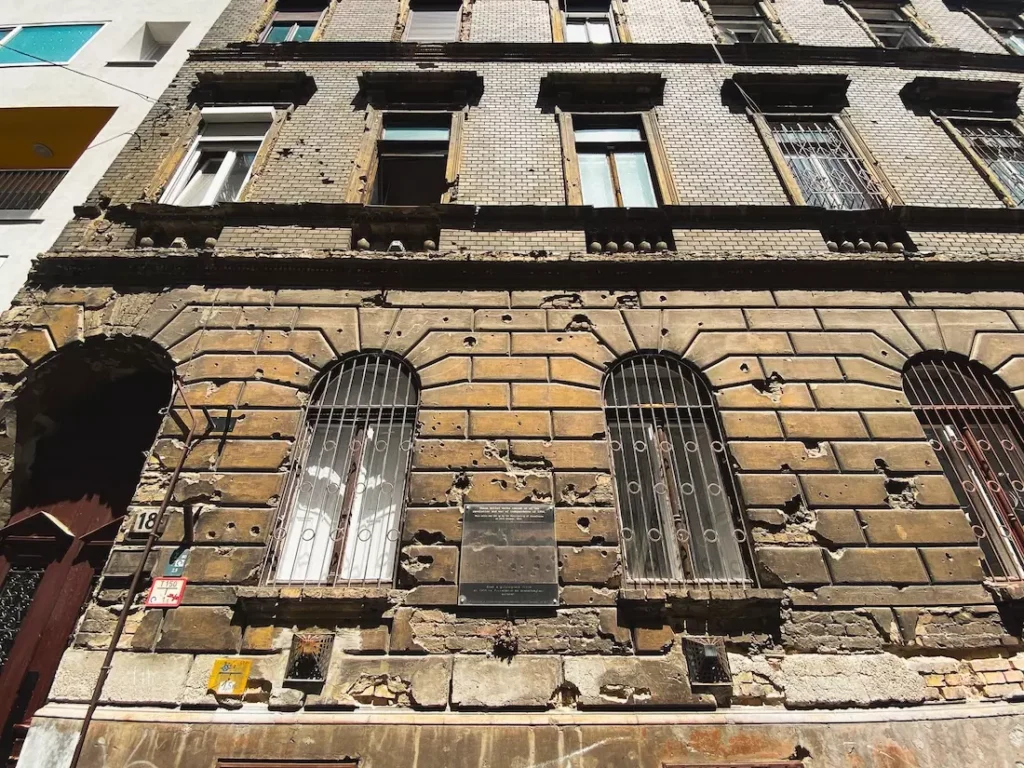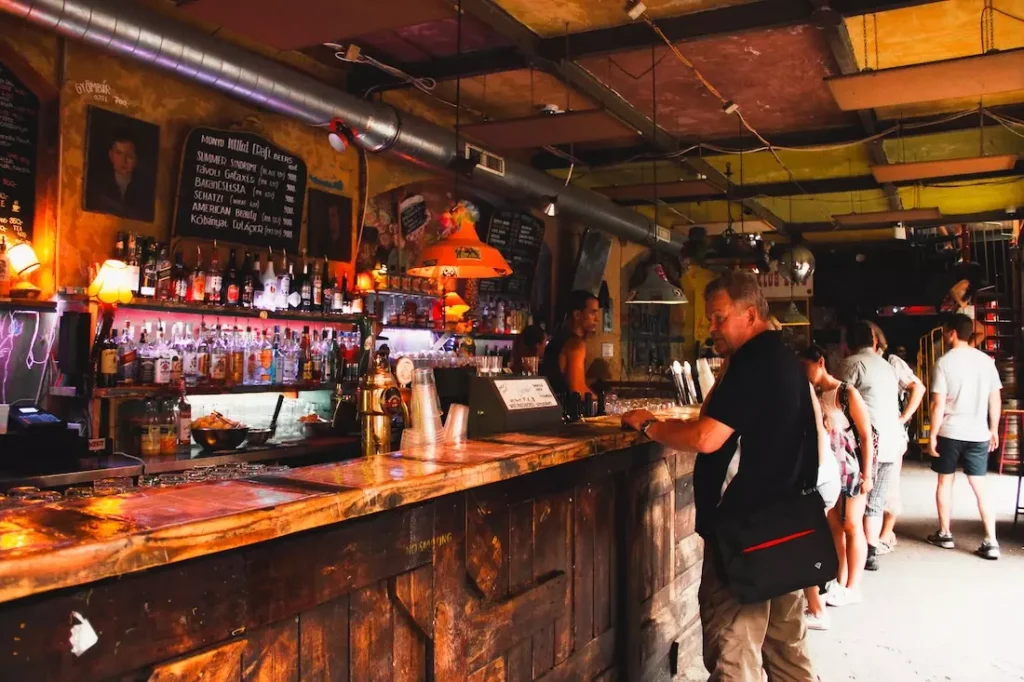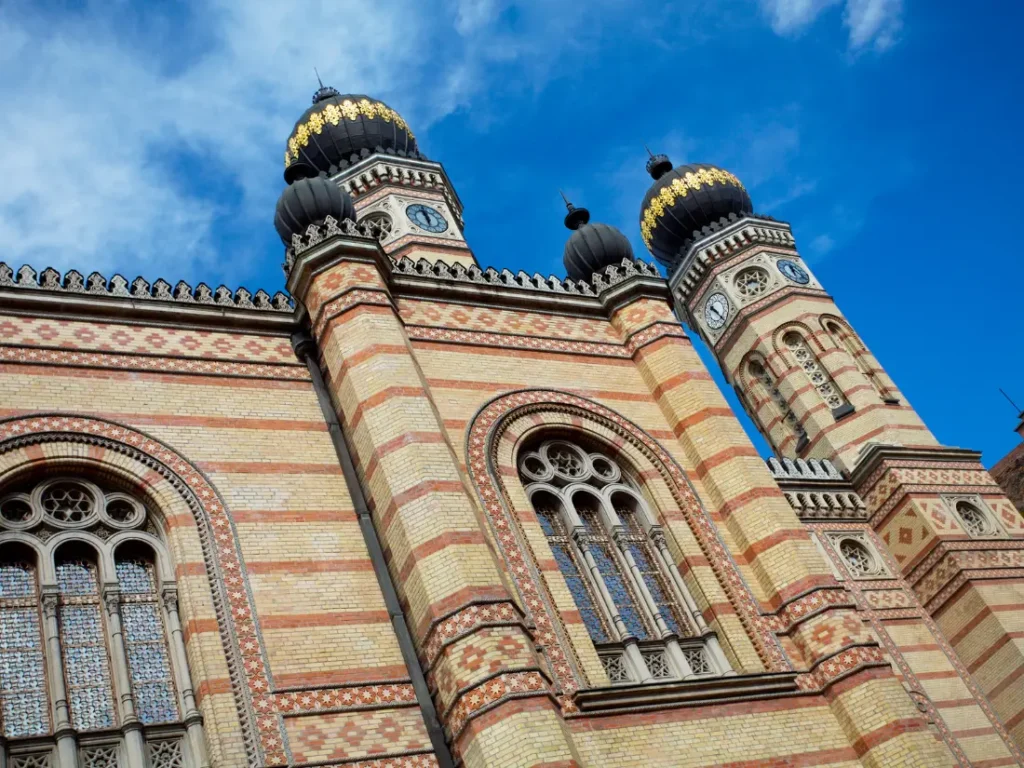Welcome to Budapest’s enchanting Jewish Quarter, the absolute heart of the city! The place is a treasure trove of culture, cuisine, and nightlife waiting to be explored.
Whether you’re a history buff, a foodie, or a night owl searching for the city’s best parties, the Jewish Quarter has something special in store for you.
So, join us on this exciting adventure through one of Budapest’s most fascinating and lively neighborhoods.
Let’s discover the hidden gems, indulge in the delicious food, and experience the pulsating energy of Budapest’s Jewish Quarter! Shall we?
The History of the Jewish Quarter In Budapest

History repeats itself in many parts of Europe. During the Second World War, Jews were forced to live in specific areas of the cities. The quarters designated to them, far from luxurious and lacking adequate infrastructure, ended up turning into decrepit ghettos. It was like this in Prague. It was like this in Krakow. It was like this in Budapest.
In the capital of Hungary, the houses where Jews were allowed to live were marked with a Star of David and were located in the quarters that extended around the main Synagogue. Tall houses and stone walls surrounded the region to prevent the residents from escaping but also to prevent people from trying to get in with forbidden items, such as food, medicines, weapons, and even information.
Just as in other cities, Jews were increasingly isolated from the outside world, turning the neighborhoods into veritable prisons. The supply of food and garbage collection were cut off. Dead bodies were left to rot in the streets.
It is estimated that more than 60,000 people lived there, in spaces that averaged 25 square meters. With so many people in such a small space and with precarious living conditions, epidemics of diseases, such as typhus, were not uncommon and contributed to the systematic degradation of the area and the mass extermination of the Jews.
The end of the war and the consequent opening of the neighborhood meant that non-Jews also started to inhabit the area, and the poor conditions of the buildings and streets made the rental prices there the lowest in the city, attracting less fortunate immigrants, prostitution, and crime.
For many years, the Jewish Quarter remained with a bad reputation: as dirty, ugly, and dangerous.
Jewish Quarter Today
Today, the grim history of the Jewish Quarter of Budapest is part of the past. The neighborhood filled up with students and artists, which led to a renewal of the streets previously marked by abandonment and human misery.
The area is now brimming with bars, restaurants, art galleries, food trucks, and design shops, becoming the main center of the city’s nightlife and culture. The most famous and oldest is Szimpla (Kazinczy Street, 11).
Right next door is Karaván, a space that brings together food trucks with food from various parts of the world. On the same street, Kuplung is also a favorite among locals.


Things to do in the Jewish Quarter
☀️ Join a Free Walking Tour around the Jewish Quarter, the best way to learn its History and curiosities from a local guide! Book it here!
Have a drink at a Ruin Bar
It was in the early 2000s that the first ruin bars began to open there. In buildings falling apart, it’s almost hard to imagine that inside are the city’s coolest places.
The first of these bars, Szimpla Kert, opened its doors in 2004. It was born out of an experimental urge to repurpose an old, dilapidated building destined for demolition. Instead of refurbishing it to modern standards, the founders embraced its decayed state, creating a raw and inviting atmosphere. This contrast was not only unique but also became the defining characteristic of Ruin Bars.
Fast-forward to today, these kinds of bars are a trademark of Budapest’s bohemian life and can be found all over the city, but the largest concentration of them is still in the Jewish Quarter. There are more than 30 establishments scattered throughout the streets of the area.
☀️ The more, the merrier! Make friends and have tons of fun joining a Ruin Pub Walking Tour in Budapest! Click here to learn more!

Visit the second-largest Synagogue in the world
With a capacity for 3,000 people, the Budapest Synagogue is the largest in Europe and one of the largest in the world, second only to the one in New York. It was this Synagogue that marked the beginning of the Budapest Jewish ghetto during the occupation. Therefore, the Jewish Quarter is in the area that extends from Dohány Street.
To enter, you need to pay a ticket of 2,000 ft (about 6 euros. Students get a discount), which gives you access not only to the temple but also to a museum that tells the history of the Jewish people from the diaspora up to the 20th century in Europe.
Inside the Synagogue, there is also a memorial to the Jews who died in the Holocaust and a monument known as the Tree of Life, a metal sculpture representing a weeping willow, located in the backyard of the Synagogue.
The monument was made in memory of the 400,000 Hungarian Jews who died during the Second World War. On the leaves of the tree, it is possible to read the names of the people who helped save lives during that time.

How to visit the Budapest Synagogue
It is not allowed to enter the Synagogue with exposed shoulders and legs. If you, like me, are visiting the city in the scorching summer, don’t worry.
At the entrance of the temple, your clothing will be checked, and they will provide paper towels for you to cover up if necessary. A souvenir shop at the entrance sells scarves for unprepared tourists, but you don’t need to buy them (especially since they are horrible).
Address: Dohány Street 2.
Hours:
- From April to October: Sunday to Friday from 10:00 am to 5:30 pm.
- From September to June: Sunday to Friday from 10:00 am to 3:30 pm. Transport: Metro line 2 (M2), Astoria station.
☀️ Book your ticket in advance here and skip the line!
Stroll through the Streets

From the beauty of the Dohány Street Synagogue with its Moorish Revival style to the elegant Art Nouveau buildings, the Jewish Quarter is a patchwork of architectural styles, each reflecting different eras and influences.
Keep an eye out for the cute hidden courtyards, some of which are tucked away behind unassuming entrances. Some hide little coffee shops and bookstores offering vintage clothes, handmade jewelry, antique books, and local crafts.
These places are also the perfect spots to take a break and people-watch while sipping a cup of coffee.
Many of these cafes also serve as informal art spaces and cultural hubs, hosting small exhibitions and events.
The street art is another feature to point out. They often delve into history, identity, and community themes and intertwine elements of Jewish culture and Hungarian folklore, creating a dynamic and colorful street gallery.

Try the Jewish-Hungarian Gastronomy
Traditional dishes with a story to tell. What else could we want? The Jewish Quarter of Budapest offers a culinary journey into Jewish-Hungarian gastronomy.
And the stars here are the Fiodine, a Hungarian Jewish pastry layered with apple, walnut, and poppy seeds, and Cholent, a slow-cooked stew that’s a Sabbath staple.
- Flódni at Rosenstein Restaurant: Renowned for its traditional Hungarian-Jewish cuisine, Rosenstein offers a homely atmosphere that complements its mouthwatering dishes. Their Flódni, a layered pastry filled with apples, walnuts, and poppy seeds, is a must-try, perfectly balancing sweetness and texture.
- Cholent at Macesz Bistro: For a taste of authentic Cholent, head over to Macesz Bistro. This cozy eatery serves up a delectable version of this slow-cooked Sabbath stew, rich in flavors and filled with tender meat, beans, and potatoes. It’s a hearty dish that warms the soul and offers a glimpse into traditional Jewish home cooking.
- Modern Twists at Fricska Gastropub: If you’re looking for a modern take on Jewish-Hungarian cuisine, Fricska Gastropub is the place to be. They are known for their innovative approach, blending traditional Jewish recipes with contemporary culinary techniques. Don’t miss their creative appetizers and entrees, which give a nod to classic Jewish flavors while surprising with modern flair.
- Street Food at Karaván: For a more casual dining experience, stroll through the buzzing street food market at Karaván. This lively spot is perfect for sampling various dishes, including Jewish-Hungarian street food staples. Look out for vendors selling kosher-style sausages, matzo ball soup, and savory pastries.
- Kosher Delights at Carmel: Carmel is an excellent choice for those strictly following kosher dietary laws. This restaurant is known for its authentic kosher menu, featuring classic dishes prepared according to traditional Jewish dietary rules. From savory goulash to sweet kugel, the flavors here are as authentic as they get.
- Dessert at Café Noé: End your culinary exploration on a sweet note at Café Noé. Famous for its array of traditional Jewish pastries and desserts, this charming café offers the perfect setting to indulge in sweet treats like rugelach, strudel, and, of course, more Flódni.
- Coffee and History at Frohlich Bakery and Café: No foodie tour is complete without a coffee break. Frohlich Bakery and Café not only serves great coffee but also offers a range of traditional Jewish pastries in a historic setting. It’s a great place to relax, reflect on your culinary journey, and maybe even plan your next visit.
Party Hard
The neighborhood is also the best place to party in Budapest. Here’s your guide to some of the most exciting places to go dancing in the Jewish Quarter:
- Instant-Fogas Complex
- For a more intense party experience, head to the Instant-Fogas complex. This massive venue, a merger of two iconic clubs, Instant and Fogasház, offers multiple dance floors, bars, and music styles under one roof. It’s like a mini-festival every night!
- Doboz
- Doboz, meaning ‘Box’, stands out with its central feature: a giant, surreal sculpture of a king’s head and a tree growing out of it. This club is known for its electric atmosphere, diverse music, including top DJs, and a lively crowd.
- Kuplung
- Once a car repair shop, Kuplung (‘Clutch’) is now a trendy spot known for its sea creature mural and relaxed vibe. Ideal for those who prefer a laid-back evening with good music, Kuplung also offers a range of live performances and DJ sets.
- Ellátó Kert
- If you’re visiting in the warmer months, don’t miss Ellátó Kert, an open-air space with a chilled-out vibe. Grab some Mexican food from the food truck, enjoy a cold drink, and dance under the stars.
- Gozsdu Courtyard
- Gozsdu Courtyard is a bustling alleyway lined with bars and restaurants, buzzing with energy and people at all times. It’s a great spot to bar-hop and enjoy a variety of vibes in one place.
- Corvin Club & Roof Terrace
- For a party with a view, head to Corvin Club, known for its rooftop terrace offering stunning city views. It’s a fantastic place to dance the night away, especially during summer parties and special DJ events.
- Boutiq Bar
- For a more upscale experience, Boutiq Bar is your go-to. Known for its expertly crafted cocktails and elegant ambiance, this bar offers a refined party experience.
- Akvárium Klub
- Finally, no party tour is complete without a stop at Akvárium Klub. Centrally located with a vast open-air terrace, it hosts concerts, events, and club nights, making it a popular spot among locals and tourists alike.
Go Shopping

This place is also a paradise for shoppers looking for unique, eclectic, and memorable items. Stores here range from vintage treasures to contemporary designer pieces.
The ‘Szputnyik Shop’ blends retro and contemporary fashion, offering vintage clothing and accessories with a story to tell.
On the other hand, places like ‘Mono Art & Design’ offer an eclectic mix of products from local designers, ranging from clothing and jewelry to art and home decor.
And don’t forget to take a look at the farmers and artisan markets, where you can find everything from organic produce to handmade crafts.
Tucked away in the nooks and crannies of the Quarter are charming second-hand bookshops. These cozy stores, like ‘Massolit Books & Café’, offer a wide range of used books, including some rare finds, perfect for book lovers looking to add to their collection.
You will also find trendy fashion boutiques offering contemporary fashion and accessories. These stores, often run by young Hungarian designers, are great spots to pick up stylish and modern apparel that reflects the latest trends in Budapest.
Suggested Read: Best Christmas Markets in Europe to Visit this Season!
Editor of Yes, Summer! I am a Brazilian journalist, writer, and digital nomad. I have been traveling the world, telling stories, and tasting local beers since 2010. I am the co-founder of 360meridianos, a reference in travel writing in Brazil, and author of the newsletter Migraciones. On social media, I'm always reachable at @natybecattini.
